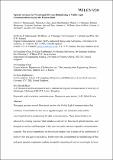Files in this item
Optical antennas for wavelength division multiplexing in visible light communications beyond the étendue limit
Item metadata
| dc.contributor.author | Manousiadis, Pavlos | |
| dc.contributor.author | Chun, Hyunchae | |
| dc.contributor.author | Rajbhandari, Sujan | |
| dc.contributor.author | Vithanage, Dimali | |
| dc.contributor.author | Malyawan, Rahmat | |
| dc.contributor.author | Faulkner, Grahame | |
| dc.contributor.author | Haas, Harald | |
| dc.contributor.author | O'Brien, Dominic C. | |
| dc.contributor.author | Collins, Steve | |
| dc.contributor.author | Turnbull, Graham A. | |
| dc.contributor.author | Samuel, Ifor David William | |
| dc.date.accessioned | 2020-12-20T00:37:16Z | |
| dc.date.available | 2020-12-20T00:37:16Z | |
| dc.date.issued | 2019-12-20 | |
| dc.identifier | 262431188 | |
| dc.identifier | 542e0176-efbd-4971-965f-c1d784dc2da5 | |
| dc.identifier | 85076747265 | |
| dc.identifier | 000503569800001 | |
| dc.identifier.citation | Manousiadis , P , Chun , H , Rajbhandari , S , Vithanage , D , Malyawan , R , Faulkner , G , Haas , H , O'Brien , D C , Collins , S , Turnbull , G A & Samuel , I D W 2019 , ' Optical antennas for wavelength division multiplexing in visible light communications beyond the étendue limit ' , Advanced Optical Materials , vol. Early View , 1901139 . https://doi.org/10.1002/adom.201901139 | en |
| dc.identifier.issn | 2195-1071 | |
| dc.identifier.other | ORCID: /0000-0001-6457-3236/work/66591892 | |
| dc.identifier.other | ORCID: /0000-0001-8678-9126/work/66591944 | |
| dc.identifier.uri | https://hdl.handle.net/10023/21181 | |
| dc.description | Funding: UK EPSRC via “Ultra-parallel visible light communications (UP-VLC)” (Programme Grant EP/K00042X/1) and “Super Receivers for Visible Light Communications” (related grants EP/R00689X/1 and EP/R005281/1). | en |
| dc.description.abstract | This paper presents a novel fluorescent receiver for visible light communications that combines a broad field of view (FoV) with a significant gain, and simultaneously enables wavelength division multiplexing (WDM) for data communications. These characteristics are achieved by creating a receiver that includes a stack of two fluorescent optical antennas, each designed to receive a different part of the spectrum and create two separable communication channels. The device outperforms the theoretical étendue limit in terms of the combination of FoV and gain it can achieve. Furthermore, the demonstrated de‐multiplexing of blue and green spectral components enables the parallel streaming of data by WDM. Since these devices are inexpensive, simple, and compact, they can easily be integrated into portable electronic devices such as phones, tablets, and laptops. | |
| dc.format.extent | 980636 | |
| dc.language.iso | eng | |
| dc.relation.ispartof | Advanced Optical Materials | en |
| dc.rights | Copyright © 2019 WILEY‐VCH Verlag GmbH & Co. KGaA, Weinheim. his work has been made available online in accordance with publisher policies or with permission. Permission for further reuse of this content should be sought from the publisher or the rights holder. This is the author created accepted manuscript following peer review and may differ slightly from the final published version. The final published version of this work is available at https://doi.org/10.1002/adom.201901139 | en |
| dc.subject | Optical wireless communications | en |
| dc.subject | Fluorescent concentrator | en |
| dc.subject | Li-Fi | en |
| dc.subject | Field of view | en |
| dc.subject | QC Physics | en |
| dc.subject | DAS | en |
| dc.subject.lcc | QC | en |
| dc.title | Optical antennas for wavelength division multiplexing in visible light communications beyond the étendue limit | en |
| dc.type | Journal article | en |
| dc.contributor.sponsor | EPSRC | en |
| dc.contributor.sponsor | EPSRC | en |
| dc.contributor.institution | University of St Andrews.School of Physics and Astronomy | en |
| dc.contributor.institution | University of St Andrews.Sir James Mackenzie Institute for Early Diagnosis | en |
| dc.contributor.institution | University of St Andrews.Centre for Biophotonics | en |
| dc.contributor.institution | University of St Andrews.Condensed Matter Physics | en |
| dc.identifier.doi | 10.1002/adom.201901139 | |
| dc.description.status | Peer reviewed | en |
| dc.date.embargoedUntil | 2020-12-20 | |
| dc.identifier.grantnumber | EP/K00042X/1 | en |
| dc.identifier.grantnumber | EP/R005281/1 | en |
This item appears in the following Collection(s)
Items in the St Andrews Research Repository are protected by copyright, with all rights reserved, unless otherwise indicated.

